
Last year, IFAD's Asia and the Pacific Division published a newsletter on 'Country responses to the food crisis'. It addressed the problem of rising food prices across Asia during 2007 and early 2008, which slowed down growth and poverty reduction in the region in the short and medium terms. The issue highlighted how governments and IFAD were addressing this challenge in some countries.
Today, the food security crisis has been put on the global agenda. The L'Aquila Summit in July 2009, which resulted in the L'Aquila Food Security Initiative, and the World Summit on Food Security in November 2009, made long-term commitments to act urgently to achieve sustainable global food security.
In spite of these efforts, food prices are again rising and fuelling inflation, and for the same structural reasons as in early 2009. In Asia, IFAD continues working with its partner countries to help them develop and implement their own food security strategies. Its emphasis is on increasing agricultural production and improving access to markets for poor rural people.
Smallholders are at the centre of IFAD's work. ". any initiative that aims to successfully tackle the food security crisis must make long-term support to smallholder agriculture a keystone," said Kanayo Nwanze, IFAD's President, at the G8 Summit in L'Aquila on 10 July 2009.
This newsletter provides some examples of national food security strategies and IFAD's work in supporting governments and smallholders to ensure food sufficiency now and in the future.
Jawaid Samaday, Knowledge Management Officer, Rural Microfinance and Livestock Support Programme in Afghanistan, describes the food security situation for the Afghan population during the last five years.
In Bangladesh, poor people suffer from periodic food shortages and a poor-quality diet. Edward Mallorie, Development Specialist, presents how, by enabling people to improve their livelihoods, IFAD-supported projects helped reduce periods of food insecurity and increased consumption of protein foods.
Through the story of Ma Taguo – a Chinese farmer – Zhao Dongqing, Programme Officer, demonstrates how IFAD is helping farmers increase their yields, improve agricultural production and meet their market service needs.
The Orissa Tribal Empowerment and Livelihoods Programme is addressing problems of food insecurity through a number of interventions. Pravanjan Mohpatra, Programme Officer, Deepak Mohanty, Former Programme Director, and Vincent Darlong, Acting IFAD Country Officer, India, describe these interventions and the efforts to ensure that project participants can continue to generate income and maintain their food, nutrition, economic, environmental and social security, from which the programme has derived the term “Food (+Plus) Security”.
Through the Rural Poverty Reduction Programme, IFAD is involved in the National Food Security Program (NFSP) of the Government of Mongolia, which aims to provide access to safe and nutritious food to the entire Mongolian population. Gun-Uyanga Soninbayar, Monitoring and Evaluation Officer, illustrates the main features of the NFSP and Mongolia’s endeavours towards achieving self-sufficiency.
Anura Herath, Country Programme Officer, explores the response of the Government of Sri Lanka to the recent food crisis and the role IFAD-supported projects could play to assist the government.
Martina Spisiakova, Newsletter Coordinator, IFAD
Useful links:
- Country responses to the food crisis, February 2009
- G8 Italia 2009
- Statement by IFAD President on the occasion of the World Summit on Food Security
Tackling food insecurity in Afghanistan
Food insecurity is a major problem for the people of Afghanistan, where 30 years of conflict, recent droughts and unstable climate have strongly deteriorated rural and urban livelihoods. Afghanistan Food Security Conditions and Causes, 2007 – a special report by the Famine Early Warning Systems Network (FEWS NET) supported by USAID – indicated that more than 60 per cent of the Afghan population suffered from low dietary diversity and poor food consumption during 2002-2007.
The following table shows the profile of food security in Afghanistan.
| Group | Percentage |
|---|---|
Low dietary diversity/very poor food consumption |
24 |
Low dietary diversity/poor food consumption |
37 |
Better dietary diversity/slightly better food consumption |
20 |
Better dietary diversity/better food consumption |
19 |
Source: Afghanistan Food Security Conditions and Causes: A special report by the Famine Early Warning Systems Network (FEWS NET), USAID, Aug 2007
In addition to the shortage of arable and irrigated land, droughts and security problems, the following factors directly affect food security in Afghanistan:
- lack of employment opportunities, and low wages and household in come
- declining livestock production
- widespread indebtedness, particularly in rural areas
- refugees and internally displaced people
- rapid growth in the urban and rural populations
- Lack and/or absence of clear government rules and policies on land management.
Moreover, in rural agricultural business a loss of export markets for agricultural and livestock products is contributing to a more precarious food security situation in the long run, as are geographically imbalanced agricultural and policy and development frameworks, which tend to focus on areas where security is relatively better.
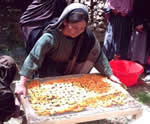
A woman drying fruit
Fortunately, increased rainfall in 2009 and a dramatic rise in the wheat harvests have opened a window of hope for improved food security in the upcoming months. Furthermore, the International Research Institute for Whether Forecast predicts a wet winter.
Nevertheless, growing insurgency in rural Afghanistan and weak governance have always been a barrier to the poverty reduction process in the country. Pakistan’s new import tax policy on Afghan agricultural products may also contribute negatively to the already unfavourable situation.
These issues have been recognized by international and national actors. Currently, the European Commission Humanitarian Aid Office, the Government of Afghanistan, Mercy Corps, the World Food Programme and World Vision International are helping the Afghan Government address food security challenges through various programmes. The National Development Strategy of Afghanistan has proposed establishing a National Food Security Programme to stimulate the agricultural and rural development process. However, this programme has yet to be created.
Most of the poor households facing food insecurity and hunger are working in the agricultural and livestock sector. International donors and the national policy makers need to focus on the issues and factors that result in food insecurity and should align their strategies in order to address them effectively. Keeping the diverse factors contributing to food insecurity in mind, multiple agricultural and livestock development activities may not produce significant results unless national and sector-based benchmarks are set for alleviating hunger and promoting food diversity. As a result, the agencies working for agricultural, livestock and rural development will need to consider enhancing the food security paradigm as an important element of their desired social and economic impact.
In addition, a National Strategy on Food Security needs to be drawn up that will effectively coordinate donor assistance. A National Poverty Reduction Strategy Paper can be used as a guideline for such a strategy. The national ownership of the strategy will also increase the potential of the public administration to work for sustainability of the aid management on achieving food security throughout the country.
Jawaid Samadey, Knowledge Management Officer, Rural Microfinance and Livestock Support Programme
Read more:
- IFAD in Afghanistan
- Future agricultural strategies on improving food security situation
- Update on food security in Afghanistan
Improving food security in Bangladesh
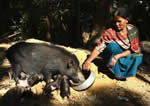
An Adivasi woman with her pigs
Poor people in Bangladesh, including households participating in IFAD-supported projects, suffer from periodic food shortages and a poor-quality diet. According to the Bangladesh National Demographic and Health Survey 2007, nationally 45 per cent of rural children under 5 years of age are stunted, 18 per cent suffer from wasting and 43 per cent are underweight. By enabling people to improve their livelihoods, IFAD-supported projects have helped reduce periods of food insecurity and increased consumption of protein foods. Surveys of households in two projects show the extent of such improvements.
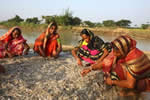
Members of the Sunamganj Community-Based Resource Management Project sorting dried fish
The Palli Karma-Sahayak Foundation/IFAD Micro-Finance and Technical Support Project commissioned a research project to investigate the impact of livestock rearing and microcredit on the livelihoods of indigenous (ethnic minority) people known as ‘adivasis’. The study was undertaken by Dr Begum Samsun Nahar, Prof. Mrs Rafiqun Nessa Ali and Mr Nasser Saleh Choudhury of the Centre for Environmental Studies at Bangladesh Agricultural University.
A sample survey of 200 project group members was carried out. Data were collected on livestock production, income, expenditure, food security and gender issues. The table below shows how the period of food shortage was reduced and more households are now able to have three meals per day during the period of the year when work is difficult to find (September to November).
| Status | No of households (%) |
|
|---|---|---|
Before |
After |
|
No. of month in food crises |
5 months |
3 months |
Can have three meals/day in normal period |
190 (90 %) |
197 (98.5%) |
Can have three meals/day in crisis period |
161 (80.5%) |
175 (87.5%) |
The table below compares project and non-project households. Although all households can normally manage three meals per day, in the crisis period, only 55 per cent of non-project households can have three meals in the crisis period, compared with 87.5 per cent of project households.
Household |
Normal situation (%) |
Crisis period (%) |
||
|---|---|---|---|---|
2 times |
3 times |
2 times |
3 times |
|
Project |
1.5 |
98.5 |
12.5 |
87.5 |
Non-project |
3.0 |
97.0 |
45.0 |
55.0 |
Total |
100 |
100 |
||
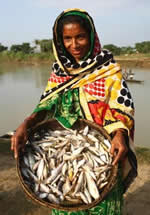
A woman displaying her catch of small fish
The Local Government Engineering Department/IFAD Sunamganj Community-Based Resource Management Project has been forming community organizations (COs), and also supporting community fisheries and developing access roads. Members of COs have been trained in:
- group building
- leadership development
- savings and credit management
- fisheries resource management
- income-generating activities including agriculture and livestock.
WorldFish Centre has recently carried out a survey of CO members on behalf of the project. The data in the table below show that the proportion of households experiencing no period of food shortage during the year increased from 20 to 37 per cent, while those with at least four months of shortage each year declined from 30 to 21 per cent.
Number of months of food shortage in a year |
Base Year (2002-5) |
2009 |
|---|---|---|
Number of households |
Number of households |
|
No shortage |
50 (20%) |
93 (37%) |
1 to 3 |
126 (50%) |
105 (42%) |
4 to 6 |
62 (25%) |
42 (17%) |
6 and above |
12 (5%) |
10 (4%) |
|
250 (100%) |
250 (100%) |
Another table below shows how the quality of diet has improved, with all households now eating meat and eggs, and two-thirds consuming milk. The frequency of consumption has also increased.
|
Meat |
Egg |
Milk |
|||
|---|---|---|---|---|---|---|
Baseline |
Impact |
Baseline |
Impact |
Baseline |
Impact |
|
Number of households consuming |
97 |
250 |
215 |
250 |
97 |
162 |
% of households consuming |
39 |
100 |
86 |
100 |
39 |
65 |
Average times per year consumed |
37 |
58 |
100 |
128 |
133 |
210 |
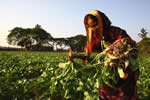
Women in Sunamganj harvesting radish
Similar results have been recorded for other projects supported by IFAD in Bangladesh. This reduction in the period of food shortage and the improvement in the quality of diet show that more money is spent on food when a household’s livelihood improves. Alternatively, more food is produced at home, some of which is consumed in the home – this is especially true with vegetables, eggs and milk. Either way, better livelihoods result in an improvement in the availability and quality of food.
Similar results have been recorded for other projects supported by IFAD in Bangladesh. This reduction in the period of food shortage and the improvement in the quality of diet show that more money is spent on food when a household’s livelihood improves. Alternatively, more food is produced at home, some of which is consumed in the home – this is especially true with vegetables, eggs and milk. Either way, better livelihoods result in an improvement in the availability and quality of food.
Edward Mallorie, Development Specialist
Read more:
IFAD-supported programme contributes to food security in Gansu Province, China
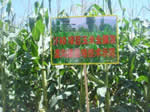
Double-ridge maize-mulching demonstration, Linxia County, Gansu
For emperors, their citizens are all important; but for the common people, food is their heaven”. The importance of food security to the Chinese is characterized by this ancient proverb that dates back some 2000 years to the Han dynasty. Its significance still resonates: China anticipates its population to reach 1.5 billion by 2030, and two of the objectives of its newly released intermediate government plan on food (until 2020) are to increase food production by 10 per cent to 545 million tons, and to reach 95 per cent food self-sufficiency. For IFAD, helping poor rural people produce sufficient food not just a matter of staving off huger but also about providing a vital source of income to support the other daily needs of the family.
Ma Taguo’s story
For Ma Taguo, a farmer in Beizhuangwan village of Dongxiang County in southern Gansu province, the South Gansu Poverty Reduction Programme (SGPRP) has helped him reach harvest yields that he has never experienced before. The programme introduced virus-free potato varieties to his 13 mu (15mu equals 1 hectare) of rainfed field . Ma had observed the good harvest in the demonstration fields of several households in the village, and decided to attend the programme training in 2008. He received the virus-free seed and planted the new variety in 2 mu of his field.
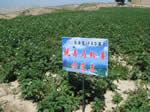
Virus-free potato demonstration field, Dongxiang County, Gansu
With guidance from programme-trained technicians, he harvested 750 kg more potato from the 2 mu than the normal variety he planted. This brought him an additional CNY 1,200 (USD 176), increasing his family’s annual income by almost 10 per cent. Ma decided to plant potato on most of his land in 2009. The weather conditions were favourable and he had another good harvest. For many farmers like Ma Taguo, new varieties of potato have helped increased their food production as well as income. In Dingxi Prefecture, the local government estimated that about one third of the average household income in 2007 was derived from growing potato. As more and more farmers are growing potatoes, market surveys were supported by the SGPRP and local governments are helping establish associations and cooperatives to help farmers work collectively in addressing their production and market service needs.
Programme activities
Improving agricultural production is one of the main components of the SGPRP, jointly supported by IFAD and the World Food Programme. It aims to achieve food security and reduce hunger and poverty. The programme covers 1.4 million people in 104 townships of 10 of the poorest counties in Southern Gansu Province, including Dongxiang County of Dingxi Prefecture.
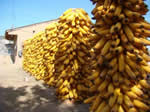
Maize harvested in Xiaozhai village, Linxia County, Gansu
The programme area is characterized by harsh weather conditions, such as extremely limited irrigation water, frequent drought, severe soil and water erosion and low fertility. Nevertheless, farmers in the programme area still rely heavily on agriculture, especially growing crops. About 88 per cent of the annual income of these farmers comes from agriculture, and 68 per cent comes solely from growing crops. As a result of such heavy dependence on crops for income and the unfavourable ecological conditions, the income of farmers in Gansu was CNY 2,329 (USD 341) per person in 2007, the lowest among all the provinces/autonomous regions/municipalities. In the same year, the average income of farmers in the country was CNY 4,140 (USD 607).
The programme has undertaken the following main activities to support food security and agricultural production:
- Land productivity improvement through terracing and irrigation facilities. The programme has terraced 5,421 hectares of sloped land, and constructed 4,905 underground irrigation tanks and 75 km of irrigation canals. The Gansu Province has its own plan to terrace about 74 per cent of the cultivable sloped land (about 3.1 million hectares in total) by 2012.
- Introduction of new crop varieties and technologies. Some 65 hectares of crops with new varieties or new cultivating technologies have been piloted, and extended to 7,132 hectares.
- Training of extensionists, technicians and demonstration farmers to help then to acquire information, technology and participatory extension services for agricultural production. The programme had trained almost 10,000 people by 2008.
- Diversified production through animal raising and forestry activities to improve household income and the ability to purchase food.
- Training of farmers in various other skills to enhance their capability for income generation to sustain their livelihood. About 12,723 beneficiaries were provided with skills training.
Mulching of maize

Plastic film mulching is an effective practice to improve water harvest and crop productivity in semi-arid areas. The most efficient and commonly applied mulching pattern in Gansu Province is two ridges and furrows mulched by one plastic film and with crops planted in the furrow between the two ridges. It helps to keep soil moisture and temperature, increase water use efficiency and advance maturity, and ultimately boost crop yield. One film maybe used for one or two years.
Mulching of maize is one important cultivation technology that has been actively promoted by the IFAD programme and local governments. The Gansu Provincial Department of Agriculture estimates that the adoption of this technology was extended to about 200,000 hectares province-wide by 2008, and contributed to a grain increase of 4.16 million tons, thus bringing farmers an additional annual income of CNY 380 (USD 56) per mu.
Xie Shaowu, a farmer in Xiaozhai village of Nanyuan township, Linxia county was pleased with the results of growing maize with the mulching technology. “I was the first demonstration household in our village to pilot the mulching technology, which started in 2007 under support from the IFAD programme,” he said. “Since then, over 500 mu of maize field in our village have been using this technology, complemented with other technologies such as new maize varieties, prescribed fertilization and integrated pest management. Taking the harvest of last year as an example, the average yield I got was 820 kg per mu, which is 131 kg more than our earlier yield average. This year I have grown maize on all my land, I am expecting a good harvest thanks to the programme’s support.”
Environment. Overall, the ecological environment for agricultural production remains fragile and vulnerable in the context of climate change. In some counties and prefectures, the crop land has in fact been reduced due to a number of reasons, including the government’s programme of “grain for green” to restore the ecological environment. The Statistical Bureau of Gansu Province estimated that the yield of main crops in Gansu has dropped by 10 per cent annually during recent years and drought affects about 68 per cent of the rural villages. Other natural calamities affect about one third of the crop areas, causing significant yield reductions.
Price fluctuations. Food is more for self-sufficiency in the programme areas. Although yields have increased for many farmers, overall the benefits have not been evident since the price of agricultural inputs has also increased significantly: farmers’ expenses in the programme area increased by about 31.7 per cent in 2008 (over 2007, and 36.7 per cent over 2006) according to the survey by the Programme Management Unit.
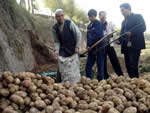
Farmers harvesting potatoes in Donxia County, Gansu
Low level of sustainability. Low human capacity and low investment in agriculture by the government as well individual farmers limited stable food production. Inadequate market services and access to information limited the income diversification of farmer livelihoods to ensure food accessibility. Subsequently about 80 per cent of rural labour in poor areas engaged only in agriculture and 94 per cent of them in the cropping industry.
The South Gansu Poverty Reduction Programme is expected to be completed by 2012. Given these challenges, efforts to address food security and poverty reduction in the programme area will need to continue.
Ms. Zhao Dongqing, Programme Officer, South Gansu Poverty Reduction Programme
Useful links:
Promoting ‘food (+Plus)’ security in the Orissa Tribal Empowerment and Livelihoods Programme, India
Food security is guaranteed by adequate production of food grains, food availability, and physical and economic access to food. A combination of economic, social, ecological and institutional factors contributes to the issue of food insecurity in the remote villages covered under the Orissa Tribal Empowerment and Livelihoods Programme. The programme is being implemented with financial assistance from IFAD and in partnership with the UK Department for International Development (DFID), and with food assistance from the World Food Programme (WFP). However the aim is to go beyond food security.
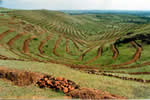
Landscape view of part of a watershed with soil and water conservation activities (Source: WOTR)
The programme
The IFAD-financed Orissa Tribal Empowerment and Livelihoods Programme aims to secure and enhance livelihoods of the poorest people living in seven districts of Orissa in India. The ten-year programme (2003-2013) currently covers 1,034 villages and 56,180 households. About 27 per cent of the households are landless and 70 per cent are under the category of marginal farmers owning less than one acre of agricultural land.
The programme uses a watershed approach for protecting and enhancing the productivity of the local natural resources and for ensuring livelihoods of tribal households. The watershed approach refers to the conservation, regeneration and judicious use of all the resources – land, water, vegetative, animal and human – within a particular watershed or drainage basin (see the picture) of a catchment area of a river or stream. Watershed development seeks to bring about an optimal equilibrium in the eco-space between natural resources, humans and animals.
Outcomes of the survey on food security
Types of families |
Livelihoods system as per dependency |
|---|---|
Landless families |
Wage, NTFP, share cropping |
Marginal/ small farmer families |
Agriculture, Wage, NTFP, Share Cropping |
Large farmer families |
Agriculture, NTFP, share cropping, animal husbandry |
The programme conducted a survey in 2005 to assess the food security situation and livelihood status of the beneficiaries, in order to design suitable programme interventions. The survey revealed the various livelihood patterns of various categories of households (Box 1). However, all of them depended on the collection and sale of Non Timber Forest Produce (NTFP) to meet their food security requirements.
The programme conducted a survey in 2005 to assess the food security situation and livelihood status of the beneficiaries, in order to design suitable programme interventions. The survey revealed the various livelihood patterns of various categories of households (Box 1). However, all of them depended on the collection and sale of Non Timber Forest Produce (NTFP) to meet their food security requirements.
Box 2. Food security scenario of different categories of tribal households at programme start-up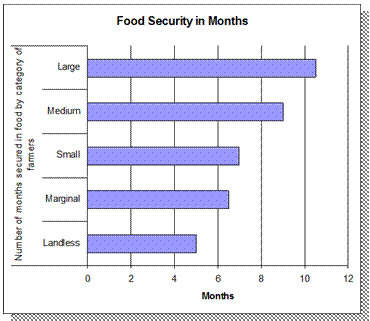
The survey also showed that none of the tribal households were food-secure for the entire year, and the landless and marginal households among them were most vulnerable, with assured food availability for only for five to seven months (Box 2). The food requirement is mostly met through the Public Distribution System (PDS), which is a special scheme of the Government of India under the food safety net. PDS provides rationed amounts of basic food items (rice, wheat, sugar, edible oils) at below-market prices to consumers, mostly households listed as below poverty line (BPL) through a network of fair price shops. This quantity-rationing food subsidy programme, however, often does not function as it should, particularly in some of the programme villages.
Addressing problems of food insecurity
More than 80 per cent of the families in the programme villages are landless and marginal. The non-availability of adequate food for about six months along with lack of wage earning opportunities for these families were major challenges for the programme at the outset. In such a context the programme adopted the strategy to create opportunities for wage employment within the village so that poor families could earn cash income.
Creating wage employment and community assets. The wage employment created as part of the programme is primarily based upon investments in enhancing the production system through large-scale land and water management activities, along with forestry/agro-forestry development. These activities are mostly designed with a “ridge to valley” approach: the upper catchment area of the watersheds (or micro watersheds) are treated with various low-cost technologies like gully plugging, contour bonding and forestry plantations. The middle part of the watersheds are mostly used by the communities for shifting cultivation, and various land development activities have been taken up to replace shifting cultivation with forestry and/or agro-forestry development. The lower parts of the watersheds are treated by constructing various water-harvesting structures linked with irrigation facilities to provide year-round irrigation to the farmers.
While ensuring increased employment opportunities, these activities are also helping to create community assets for irrigation and agricultural land development, with crop production improving and cropping intensity increasing as the productivity of the land improves. In addition, areas that were not cultivated earlier have been brought under effective cultivation. Simultaneously, the food rations from WFP, used as part of the wage payment, meet the immediate food needs.
Creating water-harvesting structures. Since 2005, the programme has helped the communities create 4,065 water-harvesting structures that support 10,701 families in irrigating their land. Through these small but critical interventions, about 3,500 hectares of land have been brought under productive cultivation, benefiting 6,481 poor households directly. These initiatives are helping mostly poor and marginal farmers in terms of safeguarding their crops from erratic rainfall and drought. The intervention, coupled with various capacity-building initiatives, particularly in farm production and livestock management, has increased the agricultural productivity, and hence food availability and livelihoods security, for the households.
Act/Rule/ |
No of households |
Area (acres) |
|---|---|---|
OPLEA |
472 |
426.82 |
OGLSR |
759 |
2,624.65 |
Vasundhara |
2,328 |
180.31 |
MJMD |
27 |
11.98 |
FRA |
3585 |
6,347.54 |
Total |
7,171 |
9,591.30 |
Establishing land security. The programme has an agenda for addressing the landlessness issue by helping landless families acquire ownership of land. Thus the programme also concentrates on securing land rights for the landless as essential element of food security, since secure land rights enables households to produce their own food. The programme is taking advantage of existing land laws such as the Orissa Prevention of Land Encroachment Act (OPLEA) and Orissa Government Land Settlement Rule (OGLSR) and schemes such as Vasundhara and Mo Jami Mo Dhia (MJMD), as well as the Forest Rights Act (FRA), to help secure land rights in the name of both the husband and wife. The programme succeeded in securing some kinds of land for at least 7,171 households that were previously landless (Box 3).
Accessing government welfare schemes. Another mandate of the programme is to help communities access government welfare schemes such as the old-age pension schemes, the BPL card for access to the PDS, and job cards for the National Rural Employment Guarantee Scheme (NREGS) meant for the tribal and poor rural populations. These schemes are primarily meant to addressing rural poverty and food insecurity.
Of all the welfare schemes, the most promising one for addressing rural poverty is the NREGS. Implemented in 2006, the scheme ensures the provision of at least 100 days of guaranteed employment to every poor rural household in one fiscal year. Implicit in the scheme is building rural infrastructure and other assets, thus making the concept of ‘decentralized planning’ a realty.
The NREGS is a well thought-out legislation, a powerful tool in the hands of the people to achieve a basic livelihood. However, its poor execution continues to deprive many of their basic rights. In this regard, the programme organizes the communities to secure job cards to access the NREGS, and provides awareness trainings on various facets of NREGS implementation including the preparation of village planning, monitoring and social auditing. In spite of concerted efforts, employment has only been provided for about 30-40 days on average annually.
Strengthening farmers’ coping strategies
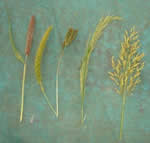
Climate-resilient less-favoured cereal crops being promoted in Orissa
Farmers also adopt strategies for crop diversification, intercropping and sequential cropping. Crop diversification strategies such as introducing seasonal and off-season vegetables, promoting less-favoured crops such as millets, and introducing semi-arid crops such as legumes (chick peas and pigeon peas) have significantly reduced incidences of food insecurity.
Furthermore, these initiatives are being supported with seed production, low-cost organic and farmyard manure and local plant-based organic pesticides. Popularizing these interventions has resulted in decreased incidence of crop failure, thus increasing food security.
Promoting kitchen gardens and vegetable cultivation in the programme area is also significantly affecting the food habits of poor tribal people, ensuring a more balanced diet and nutritional security. Women in particular are taking a very active role in these activities. They have been organized into self-help groups (SHGs) in order to gain access to credit from their own savings and financial institutions.
The important role of forests
Forests are an important resource for tribal people, who traditionally depend on collecting NTFP such as tendu leaf (Diospyros melanoxylon), seeds of the sal tree (Shorea robusta) and flowers of the Mahua tree (Madhuca longifolia) for their livelihoods. Income from these resources provides them with a safety net for their food security; collecting roots/tubers, herbs and shrubs also supplement their food basket.
In recent years, many forests in the tribal areas have been in a degraded state due to over-extraction and increasing population. Through its sub-component of Participatory Forest Management , the programme has helped organize villagers residing near the forests into Vana Sangrakhyana Samiti (VSS) or Village Forest Protection Committees. The objective is to implement participatory forest management activities that include better forest protection practices, plantations, grazing restrictions, and equitable and sustainable harvesting of NTFPs.

Tribal people in Orissa demonstrating land certificates they obtained with the help of the project
In collaboration with the State Forest and Environment Department, the programme field functionaries have organized VSSs and helped the forest dwellers to prepare forest micro plans. Based on the plans, the VSS receives funds for various activities such as nursery raising, new plantations in degraded forests, gap-filling plantations in old plantations, aided natural regeneration, moisture conservation, preparation of fire lines and regulations for grazing practices.
About 30,000 hectares of forests have now been brought under participatory forest management, which has resulted in significant improvement in the income of the communities through sustainable harvesting of NTFPs and the availability of various food supplements. In recent months, the programme has helped the communities organize themselves for “collective marketing”, in which the SHG members collect forest products from the local harvesters/collectors in volume and under their control to ensure better pricing negotiations and timely payment by the traders. This has immensely benefited the communities, ensuring higher income from the NTFPs as well as timely receipt of payment.
The ‘Output to Purpose Review’
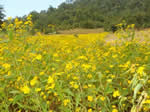
Crop diversification (Nigel oil seed cultivation) in Orissa
The Output to Purpose Review (OPR) – an evaluation tool with a statistically robust mix of design approaches promoted and implemented with support from DFID – was conducted for the programme in November 2008. The purpose of this review was to understand the status and change in livelihoods and the food security scenario in programme areas. The methodology included interviews with 320 randomly selected households in 16 programme villages in the two districts. It revealed that more than half of households indicated improvements in productivity of major agricultural crops and in their food security situation.
More than 70 per cent of households indicated increased productivity of rice, which is the major staple food, with increases of up to 36.4 per cent due to interventions in land and water management. The review also showed that the incidence of food-deficient days decreased significantly. As compared to 21 per cent of households during 2005, as many as 72 per cent of families in 2008-09 (almost midway through the programme) have sufficient food throughout the year. By the closure of the programme, it is expected that every household will attain sustainable food security.
Beyond food security
The programme’s exit strategy envisions a gradual withdrawal of support, once a self-sustaining mechanism has been established to ensure that beneficiaries can continue to generate income and maintain their food, nutrition, economic, environmental and social security, from which the programme has derived the term “Food (+Plus) Security”.
Pravanjan Mohpatra, Programme Officer
Deepak Mohanty, Former Programme Director
Vincent Darlong, Acting IFAD Country Officer, India
Read more:
Improving food self-reliance in Mongolia: the National Food Security Program
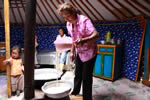
Togtohjargal, a member of a herders’ group in Ikhtamir village, in her house pouring milk
“All rice, vegetable oil and sugar are imported along with about 50 per cent of Mongolian wheat and flour,” said Mr T. Badamjunai, Minister of Food, Agriculture and Light Industry in his message to donors during the high-level donors’ consultative meeting held on 8-9 October 2009 in Ulanbator. He also stated that while Mongolia is setting objectives to attain self-sufficiency in the food staples, which can be efficiently produced in Mongolia (excluding rice and sugar), Mongolians should also care about and support the livelihoods of their poor and vulnerable people. Through the Rural Poverty Reduction Programme, IFAD is involved in the National Food Security Program of the Government of Mongolia, which aims to provide access to safe and nutritious food to the entire Mongolian population.
With a land area of 1.6 million square km, Mongolia is larger than the combined territories of France, Germany, Italy and the United Kingdom. However, the population is just 2.7 million, making Mongolia the third most sparsely populated country in the world. In rural parts of the country, the population density is less than one person per square km. Since the population is scattered over large distances, many rural households and food producers are far away from markets.
In 2007, it was estimated that 1.13 million tons of food were consumed in Mongolia. This falls short, by 25 per cent, of the recommended daily intake of 1.50 million tons. Domestic production contributed to about 75 percent of the consumption.
To respond, the Government of Mongolia approved the National Food Security Program (NFSP) for 2009-2016. The overall goal of the programme is to provide the entire nation with stable supplies of accessible, nutritious and safe food to create healthy livelihoods and high labour productivity. The programme emphasizes the participation of the people, the government, and the public and private sectors.
The IFAD-funded Rural Poverty Reduction Programme was involved in the preparation of the national programme, especially with respect to the programme’s experience in improving food security and its household support for cultivating potatoes and vegetables in rural areas.
Although national targets for staple foods such as meat, milk and potatoes were largely met by 2006-2007, food production had started to accelerate towards the end of the first programme period. Self-reliance in the major staples, along with targets and outcomes are indicated as:
Food |
Target% |
Outcome % |
|---|---|---|
Meat |
100 |
98.3 |
Milk |
100 |
95.2 |
potato |
55 |
74.3 |
Vegetable |
65 |
45.3 |
The first food security programme
The first security programme, from 2001-2007, was an ambitious endeavour to address weaknesses in the food supply chain to provide Mongolians with sufficient, safe and nutritious food and to mitigate the risk posed by over-reliance on imported food staples. Today, Mongolia is experiencing a price escalation of food staples and serious food safety incidents.
Some of the key lessons learned during the first programme were:
- The current food law failed to provide adequate clarity to regulators, industry and consumers.
- Too many organizations have over-lapping responsibilities for food security.
- The programme had too many objectives, sub-programmes and activities to be able to be implemented efficiently.
- The quality and reliability of food and agriculture data collection and analysis need to be improved to facilitate monitoring and evaluation and demand forecasting.
- While the number of livestock increased dramatically, the need now is to focus on raising productivity by improving the quality of breeding.
In terms of food stability, a number of lessons were learned:
- the need to enable beneficiaries to cope with the “hungry” period in early spring
- the need to improve the ability of poorer urban families and other vulnerable groups to cope with higher food prices in early spring
- the need to consider more innovative food access schemes for vulnerable groups (for example, social cards, vouchers) that are tailored to local situation.
The second programme
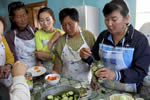
An extension training manager for women in Jargalant village demonstrating how to process vegetables
The second NFSP promotes a more pro-active, pro-poor approach to further reduce poverty and uses a more targeted strategy in partnership with the private sector. That said, the design of the second programme must factor in Mongolia’s unique situation related to food security, in particular: traditional nomadic pastoral systems in rural areas, extreme vulnerability of herders and farmers, isolation of many rural households and communities, unique food consumption patterns and seasonality, and high concentration of urban population. The second NFSP is therefore a unique opportunity to re-focus interventions on:
- food security to improve food self-reliance
- food safety to rationalize and make food management/control systems ‘fit for purpose’
- nutrition to reach the Millennium Development Goal 1 of halving hunger and under-nutrition by 2015.
The NFSP comprises four priority areas or pillars covering the following elements:
The enabling environment, which includes:
- building capacity to make necessary reforms in food policy and institutional frameworks to meet modern needs
- promoting food research, information and monitoring and evaluation.
- developing innovative financing and credit schemes for the agricultural investments such as the Agricultural Development Fund.
Food security:
This pillar focuses on two aspects. Firstly, it addresses commercial agriculture to increase national food production and generate incremental incomes in rural areas. Secondly, it supports food-insecure rural households in intensifying and diversifying their agriculture production and, in urban area, assuring their access to adequate and affordable food.
Food safety:
This pillar focuses on modernizing and expanding food processing and on rationalizing the food control management system into a modern, pro-active, cost-efficient structure.
Nutrition, which includes:
- increasing public awareness
- managing research and information
- preventing micro-nutrient deficiency
- supporting food fortification
- reducing non-communicable diseases
- promoting clean water supplies.
In his message to donors during the high-level donors’ consultative meeting, the Minister also mentioned that the NFSP embraces commercial as well as household food security and is budgeted at US$1.13 million over two phases: 2009-2012 and 2013-2016. The budget includes US$500 million to support the Agricultural Investment Fund.
Gun-Uyanga Soninbayar, Monitoring and Evaluation Officer, Rural Poverty Reduction Programme
Useful links:
The food crisis in Sri Lanka: causes and responses
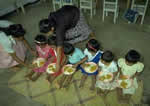
Children eating lunch at their school in Ranaketugana village
The sharp increase in food prices from 2007 through early 2009 raised serious concerns about the food and nutrition situation of poor people in developing countries. Sri Lanka is no exception. In 2007 the food price index calculated by the Food and Agriculture Organization (FAO) rose by nearly 40 per cent, compared with 9 per cent the year before, and in the first months of 2008 prices again increased dramatically. Higher food prices have different effects across countries and population groups in a country. This article briefly presents how Sri Lanka experienced the crisis, how the Government of Sri Lanka responded, and the role IFAD-supported projects could play to assist the government.
The crisis
The Food Balance Sheet of Sri Lanka (Department of Census and Statistics, 2008) shows that 81 per cent of total calories, 52 per cent of protein and 82 per cent of fat are provided by just three food items: cereal provided mainly by rice; sugar; and oil and fats, mainly from coconut. In terms of total volume consumed, 79 per cent of cereal products, 7 per cent of sugar, and 98 per cent of oil and fats are locally produced. One could deduce that the global food crisis might not have caused a crisis in Sri Lanka.
 Unfortunately, this was not the case. The figures below show an increase in the retail prices of rice and coconut, just two main commodities among many whose prices increased. The rise started during the latter part of 2007 and continued into the whole of 2008, followed by a decline. The prices were mostly stable during the second half of 2009. The increase in the Colombo Consumer Price Index (CCPI) for main food items from 141 (2002=100) in 2006 to 163 in 2007 represents a 16 per cent increase. This was slower than the increase to 200 in 2008, which was a 22 per cent increase over 2007, indicating an increase in general price levels.
Unfortunately, this was not the case. The figures below show an increase in the retail prices of rice and coconut, just two main commodities among many whose prices increased. The rise started during the latter part of 2007 and continued into the whole of 2008, followed by a decline. The prices were mostly stable during the second half of 2009. The increase in the Colombo Consumer Price Index (CCPI) for main food items from 141 (2002=100) in 2006 to 163 in 2007 represents a 16 per cent increase. This was slower than the increase to 200 in 2008, which was a 22 per cent increase over 2007, indicating an increase in general price levels.
Two major factors in Sri Lanka contributed to increased prices: the increase in food imports and decrease in domestic production of staple food. The second factor might have contributed more to the crisis.
 In 2007, Sri Lanka had imported food items worth USD 1,5 billion, an 11 per cent share of the total imports and a 3 per cent increase from 2006. The table below summarizes the changes in food imports as an index. These are de-trended values and make comparisons more meaningful. The value and volume of imported food increased at a faster rate than all imports. Food imports were encouraged by the reduction in all customs duties. Prices declined and stabilized in 2009, particularly in the latter part (the CCPI was 208 in July 2009, only an 8 point increase from 2008, indicating stability in prices). The changes in the index values show that food imports did not cause a decline in food prices until 2009.
In 2007, Sri Lanka had imported food items worth USD 1,5 billion, an 11 per cent share of the total imports and a 3 per cent increase from 2006. The table below summarizes the changes in food imports as an index. These are de-trended values and make comparisons more meaningful. The value and volume of imported food increased at a faster rate than all imports. Food imports were encouraged by the reduction in all customs duties. Prices declined and stabilized in 2009, particularly in the latter part (the CCPI was 208 in July 2009, only an 8 point increase from 2008, indicating stability in prices). The changes in the index values show that food imports did not cause a decline in food prices until 2009.
Year |
External trade indices |
% changes in indices |
||||||
|---|---|---|---|---|---|---|---|---|
Food (value) |
All items (value) |
Food (volume) |
All items (volume) |
Food (value) |
All items (value) |
Food (volume) |
All items (volume) |
|
2006 |
208.2 |
308.3 |
108.7 |
163.4 |
|
|
|
|
2007 |
242.6 |
361.4 |
116.8 |
169.5 |
17% |
17% |
7% |
4% |
2008 |
323.1 |
438.3 |
157.2 |
177.1 |
33% |
21% |
35% |
4% |
2009 |
252 |
289 |
142.6 |
125.8 |
-22% |
-34% |
-9% |
-29% |
Source: Central Bank of Sri Lanka, Bulletin (August 2009)
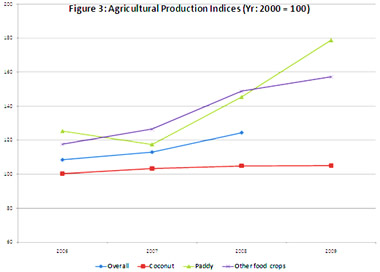 The second factor – the drop in domestic food production in 2006 and the early part of 2007 – might have contributed more to the crisis. Figure 3 provides annual production index values (seasonal variations although affected prices are not presented in the graph), where paddy shows a sharp increase after 2007 and others with a lesser rate (Central Bank of Sri Lanka, ibid).
The second factor – the drop in domestic food production in 2006 and the early part of 2007 – might have contributed more to the crisis. Figure 3 provides annual production index values (seasonal variations although affected prices are not presented in the graph), where paddy shows a sharp increase after 2007 and others with a lesser rate (Central Bank of Sri Lanka, ibid).
As a response to the drop in paddy production in 2007 (from 125 in 2006 as expressed in production indices in Figure 3, to 86.9 in the 4th quarter, which is the main cultivation season, and 117 in the full year of 2007) and a slow increase of other crops as shown in the overall index, the import of food volume in 2008 increased by about one third in comparison to 2006 (Table 1).
However, the price decline as shown by the CCPI did not follow the same rate. The changes in the CCPI values showed that food imports did not cause a decline in food prices until 2009, when production picked up. Prices declined after 4th quarter of 2008 and stabilized in 2009, particularly in the latter part. The production and price indices indicated by CCPI show that the price decline was associated with the production increase rather than the increase in food imports. This observation indicates that increasing domestic production of staple food crops is a more effective strategy to minimize the effects of a food crisis than increasing food imports.
Country responses

A smallholder farmer spraying pesticides on his rice paddy
In addition to lowering customs duties as a short-run strategy, the government responded to the food crisis through the following measures:
- Launching the national food production increase programme with the full support of the President, and calling it ‘api wawamu – rata nagamu 2007-2010’ – ‘Grow more food – for prosperity: 2007-2010’. The programme is emphasizing import substitution and organic fertilizer use, and aims to reduce chemical fertilizer by 25 per cent, thereby cutting the cost of production and associated food prices, and to promote environmentally friendly agriculture.
- Providing fertilizer at subsidized prices for paddy.
- Banning the cultivation of bio-energy crops.
- Emphasizing the need for all donor-funded projects to be aligned with the activities of the national food production programme.
Any long-term strategy to stabilize food prices will need to include increased agricultural production.
IFAD support
IFAD-funded projects in Sri Lanka, particularly the Dry Zone Livelihood Support and Partnership Programme (begun in early 2006 and operating in Anuradhapura, Badulla, Kurunegala and Moneragala), have made significant contributions to increasing the productivity and production of paddy, some food crops and dairy products. Some of the key strategies used in its support are:
- rehabilitating irrigation schemes in the rural dry zone
- imparting technology through the Farmer Field School (FFS) extension method, in which farmers have hands-on experience in using improved technologies for improving crop and dairy productivity
- improving rural infrastructure such as farm roads and storage to support marketing.
The outcomes of the Dry Zone programme are already visible in terms of yield increases of the beneficiaries:
- 10 per cent increase in paddy productivity, another 10 per cent in maize, and an almost doubling of the yield of onion (from 5.5 to 10.5 mt/ha)
- an increase from 4 litres per cow per day to 6 among dairy farmer groups in Kurunegala.
Increasing domestic food production is one promising way of combating the food crisis as shown above, where the declining food prices have followed an increase in food production. IFAD is effectively contributing to achieving this productivity improvement in selected crops in rural areas albeit on a limited scale.
Anura Herath, Country Programme Officer, IFAD
Useful links:
- Economic and financial reports of the Central Bank of Sri Lanka
- Price statistics: Colombo Consumers’ Price Index
- Food balance sheet of the Government of Sri Lanka
- Daily News, September 2009: Local food production drive
- Movement for Land and Agricultural Reform: Campaign for people’s solutions to the food crisis
Bangladesh
Implementation support mission – National Agricultural Technology Project, January 2010
Implementation support mission – Sunamganj Community-Based Resource Management Project, January–February 2010
Writeshop in communications, 8–12 March 2010
Loan negotiations – Char Development and Settlement Project, 22-26 March 2010
IFAD/FAO Study Tour – ‘Microfinance for Marginal and Small Farmers, Reaching the Target Group’, 27 - 31 March 2010
Cambodia
Loan signing – Tonle Sap Poverty Reduction and Smallholder Development Project, 15 February 2010
Asia and the Pacific Gender Strategy Workshop, Siem Reap Province, 22–25 February 2010
Detailed design mission – Community-based Agricultural Productivity Project, February – March 2010
China
Project completion evaluation workshop – West Guangxi Poverty-Alleviation Project, Guangxi, 15-17 January 2010
Follow-up mission – Inner Mongolia Autonomous Region Rural Advancement Programme, 25-31 January 2010
Preparatory mission for country programme review, 18-31 January 2010
Follow-up mission – Dabieshan Area Poverty Reduction Programme, Henan, 25-31 January 2010
Follow-up mission – Sichuan Post-Earthquake Agricultural Rehabilitation Project, 25-31 January 2010
Implementation support mission – Sichuan Post-Earthquake Agricultural Rehabilitation Project, 22-28 February 2010
Follow-up mission – South Gansu Poverty Reduction Programme, 1-7 March 2010
Project completion review – Rural Finance Sector Programme, Shaanxi & Chongqing, 1-21 March 2010
Country program review mission – 1 March – 17 April 2010
Indonesia
Implementation support mission – Rural Empowerment and Agricultural Development Programme in Central Sulawesi, January 2010
Assessment of Mars Cocoa Development Center – National Programme for Community Empowerment (PNPM), January–February 2010
Evaluation of technical and financial proposals for a social assessment in Indonesia – February 2010
Laos
Financial management mission – Rural Livelihoods Improvement Programme, 4-16 January 2010
Inception mission – Sustainable Natural Resource Management and Productivity Enhancement Project, 17-21 January 2010
Maldives
Start-up mission – Fisheries and Agricultural Diversification Project, 24-28 January 2010
Loan administration and finance training – Fisheries and Agricultural Diversification Project, 5-9 March 2010
Nepal
Implementation support mission – Skills Enhancement and Employment Project, January 2010
Implementation support mission – Western Uplands Poverty Alleviation Project, January 2010
Mid-term evaluation mission – Western Uplands Poverty Alleviation Project, March 2010
Pakistan
Preparation of audit logs for all projects, January 2010
Financial management review mission – Southern Federally Administered Tribal Areas Development Project, January–February 2010
Financial management training – Crop Maximization Support Project, February 2010
Detailed design mission – new coastal project, February-March 2010
Writeshop in communications – 15-18 March 2010
Design completion – Southern Punjab Project, March-April 2010
Philippines
Start-up mission – Rapid Food Production Enhancement Programme, 11-18 January 2010
Monitoring mission – Rapid Seed Supply Project, 20 January – 3 February 2010
Loan administration and finance training – Rapid Food Production Enhancement Programme, 20-24 February 2010
Monitoring mission – Rapid Seed Supply Project, 25 February – 2 March 2010
Stakeholder meeting for COSOP, 4-6 March 2010
Post-supervision visit – Rural Microenterprise Promotion Programme, 4 March 2010
Project completion review mission – Northern Mindanao Community Initiatives and Resource Management Project, 10-26 March 2010
Sri Lanka
Procurement review mission – Post-Tsunami Livelihoods Support and Partnership Programme, 25 January – 4 February 2010
Field visit – Smallholder Plantations Entrepreneurship Development Programme, beginning of February 2010
Participation in World Bank supervision mission Dry Zone Livelihood Support and Partnership Programme , 8-17 February 2010
Stakeholder workshop – Smallholder Plantations Entrepreneurship Development Programme, 3 March 2010
Wrap-up high level meeting for the Country Strategy Opportunity Programme (COSOP), 9 March 2010
Post-supervision visit – Post-Tsunami Coastal Rehabilitation and Resource Management Programme, 31 March 2010
Viet Nam
Annual COSOP implementation review – 6-7 January 2010
Mid-term review mission – Improving Market Participation for the Poor in Tra Vinh, 10-21 January 2010
Mid-term review mission – Improving Market Participation for the Poor in Ha Tinh, 22-30 January 2010
Completion report and institutional assessment – Rural Income Diversification Project in Tuyen Quang, 25–30 January and late March 2010
Formulation mission – a new project in Ninh Thuan, 10-21 January 2010
Formulation mission – a new project in Gia Lai, 23 February – 12 March 2010